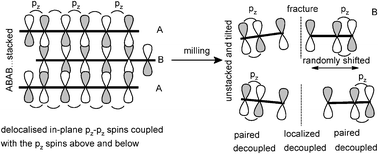Defect induced electronic states and magnetism in ball-milled graphite
Abstract
The electronic structure and magnetism of nanocrystalline graphite prepared by

* Corresponding authors
a
School of Science and Health, University of Western Sydney, Locked Bag 1797, Penrith, New South Wales 2751, Australia
E-mail:
a.milev@uws.edu.au
Fax: +612 96859915
Tel: +612 96859945
b
Sri Lanka Institute of Nanotechnology (SLINTEC), Lot 14, Zone 1, Biyagama EPZ, Colombo, Biyagama, Sri Lanka
E-mail:
asurasinghek@slintec.lk, arkumarasinghe@yahoo.co.uk
Fax: +94-011-4741995
Tel: +94-011-4650507
c
Faculty of Science and Technology, Uva Wellassa University, Passara Road, Badulla, Sri Lanka
E-mail:
ark@uwu.ac.lk
Tel: +94-055-3559113
The electronic structure and magnetism of nanocrystalline graphite prepared by

 Please wait while we load your content...
Something went wrong. Try again?
Please wait while we load your content...
Something went wrong. Try again?
A. Milev, D. M. A. S. Dissanayake, G. S. K. Kannangara and A. R. Kumarasinghe, Phys. Chem. Chem. Phys., 2013, 15, 16294 DOI: 10.1039/C3CP52657G
To request permission to reproduce material from this article, please go to the Copyright Clearance Center request page.
If you are an author contributing to an RSC publication, you do not need to request permission provided correct acknowledgement is given.
If you are the author of this article, you do not need to request permission to reproduce figures and diagrams provided correct acknowledgement is given. If you want to reproduce the whole article in a third-party publication (excluding your thesis/dissertation for which permission is not required) please go to the Copyright Clearance Center request page.
Read more about how to correctly acknowledge RSC content.
 Fetching data from CrossRef.
Fetching data from CrossRef.
This may take some time to load.
Loading related content
